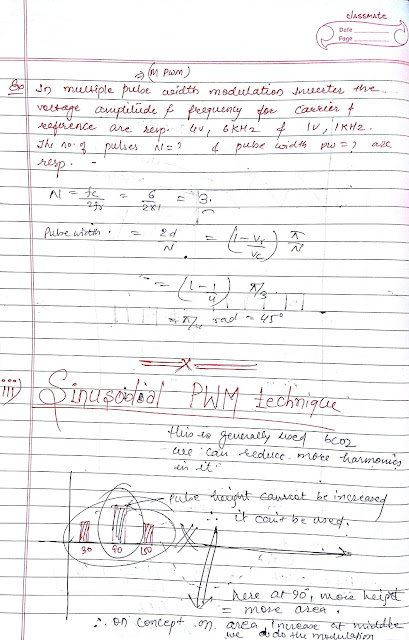Download the notes from below link (in pdf) :
Download the notes in small file size from 2nd link:
Following topics are included in this notes:
1. Introduction
2. Classification of inverter:
a) Voltage source inverter
1 phase half bridge inverter
1 phase full bridge inverter
3 phase voltage source inverter
b) Current inverter
c) Series inverter
d) Parallel inverter
1. Voltage Source Inverter (VSI)
Discussed topics in each case are:
a) Circuit diagram
b Modes of operation
c graphs of voltage and current
d) Harmonics of output voltage waveform
1. 1 phase half bridge inverter
2. 1-Phase full bridge inverter
3. 1 phase full bridge inverter for Inductive load
4. 1 phase full bridge inverter for RLC load
5. 3-Phase Voltage source inverter
a) 180 degree conduction mode
b) 120 degree conduction mode
2. Current Source Inverter
Circuit diagram, Modes of operation and graphs
advantages, drawbacks, application of CSI
3. Series Inverter
a) Modes of operation, Circuit diagram
b) Resonant Converter
4. Parallel Inverter
a) Circuit diagram, Modes of Operation
b) Drawbacks
5. Voltage Control of Inverter
a) External Control
b) Internal Control using PWM techniques
6. PWM (Pulse Width Modulation) Techniques:
a) Single Pulse width modulation technique
graphs, harmonics elimination
b) Multiple pulse width modulation techniques
c) Sinusoidal PWM Technique
Download the notes in small file size from 2nd link:
Following topics are included in this notes:
1. Introduction
2. Classification of inverter:
a) Voltage source inverter
1 phase half bridge inverter
1 phase full bridge inverter
3 phase voltage source inverter
b) Current inverter
c) Series inverter
d) Parallel inverter
1. Voltage Source Inverter (VSI)
Discussed topics in each case are:
a) Circuit diagram
b Modes of operation
c graphs of voltage and current
d) Harmonics of output voltage waveform
1. 1 phase half bridge inverter
2. 1-Phase full bridge inverter
3. 1 phase full bridge inverter for Inductive load
4. 1 phase full bridge inverter for RLC load
5. 3-Phase Voltage source inverter
a) 180 degree conduction mode
b) 120 degree conduction mode
2. Current Source Inverter
Circuit diagram, Modes of operation and graphs
advantages, drawbacks, application of CSI
3. Series Inverter
a) Modes of operation, Circuit diagram
b) Resonant Converter
4. Parallel Inverter
a) Circuit diagram, Modes of Operation
b) Drawbacks
5. Voltage Control of Inverter
a) External Control
b) Internal Control using PWM techniques
6. PWM (Pulse Width Modulation) Techniques:
a) Single Pulse width modulation technique
graphs, harmonics elimination
b) Multiple pulse width modulation techniques
c) Sinusoidal PWM Technique
 |
| Page 1a |
 |
| Page 1b |
 |
| Page 2a |
 |
| Page 2b |
 |
| Page 3a |
 |
| Page 3b |
 |
| Page 4a |
 |
| Page 4b |
 |
| Page 5a |
 |
| Page 5b |
 |
| Page 6a |
 |
| Page 6b |
 |
| Page 7a |
 |
| Page 7b |
 |
| Page 8a |
 |
| Page 8b |
 |
| Page 9a |
 |
| Page 9b |
 |
| Page 10a |
 |
| Page 10b |
 |
| Page 11a |
 |
| Page 11b |
 |
| Page 12a |
 |
| Page 12b |
 |
| Page 13a |
 |
| Page 13b |
 |
| Page 14a |
 |
| Page 14b |
 |
| Page 15a |
 |
| Page 15b |
 |
| Page 16a |
 |
| Page 16b |
 |
| Page 17a |
 |
| Page 17b |
 |
| Page 18a |
 |
| Page 18b |
 |
| Page 19a |
 |
| Page 19b |
 |
| Page 20a |
 |
| Page 20b |
 |
| Page 21a |
 |
| Page 21b |
 |
| Page 22a |
 |
| Page 22b |
 |
| Page 23a |
 |
| Page 23b |
 |
| Page 24a |
 |
| Page 24b |
 |
| Page 25a |
 |
| Page 25b |
 |
| Page 26a |
 |
| Page 26b |
 |
| Page 27a |
 |
| Page 27b |
 |
| Page 28a |
 |
| Page 28b |
 |
| Page 29a |
 |
| Page 29b |
 |
| Page 30a |
 |
| Page 30b |
 |
| Page 31a |
 |
| Page 31b |
 |
| Page 32a |
